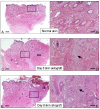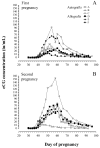The effect of skin allografting on the equine endometrial cup reaction
- PMID: 17559923
- PMCID: PMC2259290
- DOI: 10.1016/j.theriogenology.2007.04.058
The effect of skin allografting on the equine endometrial cup reaction
Abstract
This research tested the hypothesis that immunological sensitization of mares by skin allografting, followed by the establishment of pregnancy using semen from the skin-graft donor, would give rise to secondary immune responses to the developing horse conceptus, resulting in an earlier demise of the fetally derived endometrial cups. Maiden mares received skin allografts from a stallion homozygous for Major Histocompatibility Complex (MHC) antigens and/or equivalent autografts and were subsequently mated to the skin-graft donor stallion during the next two breeding seasons. Mares that had been immunologically primed to the foreign MHC class I antigens of the skin-graft donor stallion developed strong secondary antibody responses early in their first pregnancies, whereas autografted mares made weak primary antibody responses in their first pregnancies and strong secondary responses in their second pregnancies. In contrast, histological examination of the endometrial cups after surgical pregnancy termination at Day 60 of gestation revealed no discernible differences between allografted and autografted mares, and there were no significant differences in the concentrations and/or duration of secretion of the endometrial cup-specific hormone, equine chorionic gonadotrophin (eCG), between allografted and autografted mares, nor in either group between first and second pregnancies. The vigorous antibody response observed in the pregnant allografted mares supported the first part of our hypothesis, providing evidence of systemic immunological priming. However, there was a lack of an equivalent heightened cellular response to the endometrial cups. These findings provided strong evidence for an asymmetric immune response to the conceptus, characterized by strong humoral immunity and a dampened cellular response.
Figures





Similar articles
-
Split immunological tolerance to trophoblast.Int J Dev Biol. 2010;54(2-3):445-55. doi: 10.1387/ijdb.082795ad. Int J Dev Biol. 2010. PMID: 19876828 Free PMC article.
-
Expression of major histocompatibility complex (MHC) antigens on horse trophoblast.J Reprod Fertil Suppl. 1987;35:379-88. J Reprod Fertil Suppl. 1987. PMID: 3479592
-
Invasive equine trophoblast expresses conventional class I major histocompatibility complex antigens.Development. 1990 Sep;110(1):63-71. doi: 10.1242/dev.110.1.63. Development. 1990. PMID: 2081471
-
Maternal immunological recognition of pregnancy in equids.J Reprod Fertil Suppl. 1989;37:69-78. J Reprod Fertil Suppl. 1989. PMID: 2681748 Review.
-
The equine immune response to endometrial cups.J Reprod Immunol. 1997 Oct;34(3):203-16. doi: 10.1016/s0165-0378(97)00044-2. J Reprod Immunol. 1997. PMID: 9350637 Review.
Cited by
-
Ectopic Trophoblast Allografts in the Horse Resist Destruction by Secondary Immune Responses.Biol Reprod. 2016 Dec;95(6):135. doi: 10.1095/biolreprod.115.137851. Epub 2016 Oct 19. Biol Reprod. 2016. PMID: 27760752 Free PMC article.
-
Equine allogeneic bone marrow-derived mesenchymal stromal cells elicit antibody responses in vivo.Stem Cell Res Ther. 2015 Apr 12;6(1):54. doi: 10.1186/s13287-015-0053-x. Stem Cell Res Ther. 2015. PMID: 25889095 Free PMC article.
-
The equine endometrial cup reaction: a fetomaternal signal of significance.Annu Rev Anim Biosci. 2013 Jan;1:419-42. doi: 10.1146/annurev-animal-031412-103703. Epub 2012 Dec 13. Annu Rev Anim Biosci. 2013. PMID: 25387026 Free PMC article. Review.
-
Major histocompatibility complex I mediates immunological tolerance of the trophoblast during pregnancy and may mediate rejection during parturition.Mediators Inflamm. 2014;2014:579279. doi: 10.1155/2014/579279. Epub 2014 Apr 9. Mediators Inflamm. 2014. PMID: 24812442 Free PMC article. Review.
-
Split immunological tolerance to trophoblast.Int J Dev Biol. 2010;54(2-3):445-55. doi: 10.1387/ijdb.082795ad. Int J Dev Biol. 2010. PMID: 19876828 Free PMC article.
References
-
- Rapaport FT, Converse JM. Observations on immunological manifestations of the homograft rejection phenomenon in man: The recall flare. Ann N Y Acad Sci. 1957;64:836–841. - PubMed
-
- Medawar PB. Some immunological and endocrinological problems raised by the evolution of viviparity in vertebrates. Symp Soc Exp Biol. 1953;44:320–338.
-
- Hunt JL, Petroff MG, McIntire RH, Ober C. HLA-G and immune tolerance in pregnancy. FASEB J. 2005;19:681–693. - PubMed
-
- Moffett A, Loke C. Immunology of placentation in eutherian mammals. Nat Rev Immunol. 2006;6:584–594. - PubMed
Publication types
MeSH terms
Substances
Grants and funding
LinkOut - more resources
Full Text Sources
Research Materials

